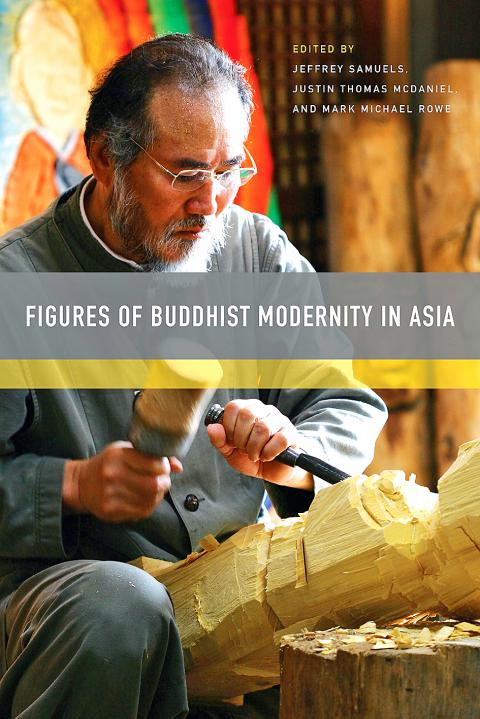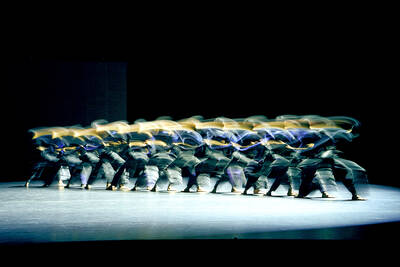A layman devoting himself to the creation of digitally animated cartoons of Buddhist mythology in vibrant red, orange and purple; an educator who has introduced radical reforms such as the study of psychology and Western philosophy into Buddhist seminary curricula and a translator and New Age apologist with a background as a movie star — these three Taiwanese Buddhists feature in this new book about devotees throughout Asia who strive to integrate, in their very different ways, traditional Buddhist teachings with the modern world.
Figures of Buddhist Modernity in Asia is a collection of profiles of individuals who combine religious tradition with contemporary life. They range from, in the words of the editors, “Buddhist Web masters in Taiwan, members of international Buddhist women’s organizations in Vietnam, internationally known singing nuns in Nepal, Buddhist air-traffic controllers in Burma” to “alcoholic translators of Confucian texts in Laos … charlatans, hucksters, profiteers and rabble-rousers.”
The first Taiwanese to be discussed is known by the simple name of Cide. He works out of the Posha Shan Faming Temple in Zhonghe in New Taipei City, and is the son of the former businessman turned abbot, Chanjing, who heads the temple. Cide is a follower of the famous reforming Chinese monk Taixu (1890 to 1947), a key figure in “Humanistic Buddhism.”

Central to Cide’s work is the Internet. He showed the interviewer a clip from the then incomplete digitally animated cartoon of the Sutra of Maitreya’s Ascent, and in addition there are Web sites devoted to the temple’s history (it was once the current abbot’s factory) where the delights on offer include virtual lamp-lighting.
The profiles that comprise this book are all penned by different people, and the profiler and interviewer responsible for this item says Cide represents crucial aspects of modern Taiwan — economic development put to other — in this case spiritua — uses, increased links with China and, in the specifically Buddhist context, the “growing but ambivalent” role of lay leadership.
The second Taiwan personality featured is the monk known as Houguan (厚觀). Born in Miaoli County in 1956, he studied under the celebrated Dharma Master Yin Shun (印順法師, 1906 to 2005) who’s credited with spearheading Taiwanese Buddhist modernity. Yin Shun’s most famous pupil is the Master Cheng Yen (證嚴法師) who founded the hugely successful Tzu Chi Foundation. But in the field of Buddhist education it’s Houguan who is the star figure.
He’s credited with upgrading the curricula of Buddhist seminaries, pioneering the use of new media in teaching both monastics and laity and making strenuous efforts to arrange cross-strait Buddhist symposia. Also important is his incorporation of the reforms undertaken in China by Taixu, exemplified by the inclusion of secular subjects such as psychology and Western philosophy, plus a critical and philological approach to ancient Buddhist texts. This can be compared to the textual criticism of the Bible (who wrote which books, can they all be considered authentic?) pioneered against strenuous opposition in Germany in the early 19th century.
Houguan has spent much of his life as dean and teacher at Taiwan’s Fu Yan Buddhist Institute (福嚴佛學院). He’s also president of the Yin Shun Buddhist Cultural Foundation, an organization that promotes Yin Shun’s teachings.
Modern technology also features in his teaching practice. The Fu Yan Buddhist Institute has a Web site that contains “all the notes” of Houguan’s and other teachers’ lectures as downloadable files. It also has its own channel on YouTube where Houguan and his colleagues can be watched lecturing in regularly uploaded videos.
The third Taiwanese Buddhist celebrity to be featured in this book is Terry Hu (胡因夢). Born in 1953, she was once a popular movie star, but then went on to be a promoter of the books of the Indian Theosophist called Jiddu Krishnamurti (1895 to 1986). However, she had her own take on his writings, re-launching him in Taiwan as an essentially Buddhist figure.
Having the popular touch is central to Hu’s style. At one public meeting in Taipei in 2013 she was accompanied on the platform by a physics professor and tai chi exponent and a cosmetics entrepreneur. Earlier in her life, in 1979, she’d met the prominent Taiwanese writer and public intellectual Li Ao (李敖) who she “quickly married and divorced,” according to the author of this profile.
After working in the US, she returned to Taiwan in the 1980s and became deeply involved in the emerging New Age movement. In her 1987 guide to the New Age, Ancient Future (古老的未來), she criticized what she saw as the authoritarian tendencies of Chinese culture in Taiwan. She also argued that Krishnamurti’s later work exemplified the essence of Zen Buddhism, despite his never having used the term. She also stressed how anti-authoritarian in general New Age teachings were, and introduced Buddhist terminology wherever possible in order the make the movement more accessible to her Taiwanese readers.
Also profiled is Columbia University’s Yu Chun-fang (於君方), author of the monumental Kuan-yin: The Chinese Transformation of Avolokitesvara (2001). Her grandmother had been an ardent devotee of Guanyin (觀音), but following the family’s move from China to Taiwan Yu was moved to comment that from the 1950s to the 1970s Buddhism had a far lower profile in Taiwanese universities than Christianity. It was only when she realized that the perspective in American academic life was very different that she felt ready to embark on her great work.
This is an exceptional book as regards its sheer range, but its Taiwan-related material is especially insightful. Its position is that Taiwan is unique in the way it combines progressive modern technology and its related attitudes (almost always libertarian) with ancient, traditional Buddhist insights. As such, it is positioned to be the Asian leader in such matters, if it hasn’t already become so.

Most heroes are remembered for the battles they fought. Taiwan’s Black Bat Squadron is remembered for flying into Chinese airspace 838 times between 1953 and 1967, and for the 148 men whose sacrifice bought the intelligence that kept Taiwan secure. Two-thirds of the squadron died carrying out missions most people wouldn’t learn about for another 40 years. The squadron lost 15 aircraft and 148 crew members over those 14 years, making it the deadliest unit in Taiwan’s military history by casualty rate. They flew at night, often at low altitudes, straight into some of the most heavily defended airspace in Asia.

This month the government ordered a one-year block of Xiaohongshu (小紅書) or Rednote, a Chinese social media platform with more than 3 million users in Taiwan. The government pointed to widespread fraud activity on the platform, along with cybersecurity failures. Officials said that they had reached out to the company and asked it to change. However, they received no response. The pro-China parties, the Chinese Nationalist Party (KMT) and Taiwan People’s Party (TPP), immediately swung into action, denouncing the ban as an attack on free speech. This “free speech” claim was then echoed by the People’s Republic of China (PRC),

Many people in Taiwan first learned about universal basic income (UBI) — the idea that the government should provide regular, no-strings-attached payments to each citizen — in 2019. While seeking the Democratic nomination for the 2020 US presidential election, Andrew Yang, a politician of Taiwanese descent, said that, if elected, he’d institute a UBI of US$1,000 per month to “get the economic boot off of people’s throats, allowing them to lift their heads up, breathe, and get excited for the future.” His campaign petered out, but the concept of UBI hasn’t gone away. Throughout the industrialized world, there are fears that

Like much in the world today, theater has experienced major disruptions over the six years since COVID-19. The pandemic, the war in Ukraine and social media have created a new normal of geopolitical and information uncertainty, and the performing arts are not immune to these effects. “Ten years ago people wanted to come to the theater to engage with important issues, but now the Internet allows them to engage with those issues powerfully and immediately,” said Faith Tan, programming director of the Esplanade in Singapore, speaking last week in Japan. “One reaction to unpredictability has been a renewed emphasis on